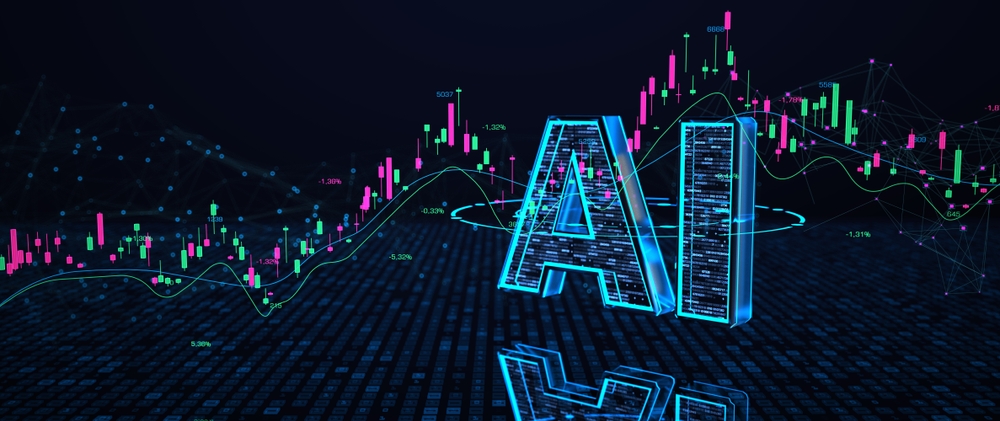AI Beginnings in Finance
Artificial Intelligence, or AI, has become a buzzword in the modern world, transforming industries and redefining how we live, work, and play. The finance sector is no exception to this technological revolution. The fusion of AI and finance has opened up a new realm of possibilities, creating a dynamic ecosystem where machine intelligence drives financial decision-making.
The journey of AI in finance is a fascinating tale of innovation and evolution. It began with simple automation, where routine tasks were delegated to machines, freeing up human resources for more complex tasks. However, the advent of AI has taken this automation to a whole new level. Today, AI is not just about performing tasks; it’s about learning, adapting, and making decisions.
The adoption of AI in finance has been nothing short of phenomenal. A study by Arner, Barberis, and Buckley in 2016 titled “Artificial Intelligence in Finance: From Myth to Reality” reveals that 77% of financial institutions have adopted AI in some form, and this number is only expected to grow. This statistic underscores the growing relevance of AI in the finance sector and sets the stage for our exploration of this topic.
The AI Revolution in Finance
Artificial Intelligence, often simply referred to as AI, is a broad term that encompasses various technologies, including machine learning, natural language processing, and robotics. In the context of finance, AI refers to the use of these technologies to automate, enhance, and innovate financial services and operations.
The story of AI in finance is not a recent one. It dates back to the 1950s when the first automated teller machines (ATMs) were introduced. However, the real game-changer was the advent of machine learning in the late 20th century, which allowed computers to learn from data and make predictions or decisions without being explicitly programmed to do so.
The paper “Artificial Intelligence in Finance: A review and new research directions” by Min, Lee, and Han (2020) provides a comprehensive overview of the evolution of AI in finance. It highlights the shift from rule-based systems to learning-based systems, marking a significant milestone in the journey of AI in finance.
But how does AI work in the financial sector? Let’s break it down with a simple example. Consider a credit card company that wants to detect fraudulent transactions. Traditionally, this would involve setting up rules based on past fraud patterns. However, fraudsters are always evolving their tactics, making it hard to keep up with rule-based systems.
Enter AI. With machine learning, the system can learn from past data, identify patterns, and adapt to new fraud tactics. It can analyze a multitude of factors in real-time, such as the location of the transaction, the amount, the time of day, and even the buying behavior of the cardholder, to determine the likelihood of a transaction being fraudulent. This is just one of the many ways AI is revolutionizing finance, making it more efficient, secure, and customer-centric.
AI Takes the Financial World by Storm
Artificial Intelligence has permeated every corner of the financial sector, leaving no stone unturned. Its applications are as diverse as they are transformative. Let’s explore some of the key areas where AI has made its mark.
First, let’s talk about Algorithmic Trading. This is the process of using computer programs to follow a defined set of instructions for placing a trade, with the aim of generating profits at a speed and frequency that is impossible for a human trader. The paper “Artificial Intelligence in Finance: AI is the New Factor of Production in the Financial Sector” by Ardia, Bluteau, and Rüede (2019) provides an in-depth look at how AI has revolutionized this aspect of finance. Machine learning algorithms can analyze vast amounts of financial data, identify patterns, and make trading decisions in real-time, providing a significant edge in the fast-paced world of financial markets.
Next, we have Risk Management. Financial institutions are constantly faced with the challenge of assessing and managing a wide range of risks, from credit risk to market risk. AI comes into play here by providing sophisticated models that can predict potential risks based on historical data and real-time insights. This allows financial institutions to make more informed decisions and mitigate risks effectively.
Fraud Detection is another critical application of AI in finance. As we discussed in the previous section, AI can analyze a multitude of factors in real-time to detect fraudulent activities. This not only enhances the security of financial transactions but also improves the customer experience by reducing false positives.
Finally, let’s look at Customer Service. AI-powered chatbots and virtual assistants are becoming increasingly common in the financial sector, providing personalized services to customers round the clock. These AI tools can handle a wide range of tasks, from answering customer queries to providing financial advice, making banking more convenient and accessible for everyone.
To illustrate these applications, consider including an infographic or chart that provides a visual representation of how AI is transforming finance. This can make the content more engaging and easier to understand for the readers.
The AI Advantage in Finance
The integration of Artificial Intelligence into the financial sector has brought about a host of benefits. These advantages are not just limited to the financial institutions themselves, but also extend to their customers and the broader economy.
One of the most significant benefits of AI in finance is increased efficiency. By automating routine tasks, AI frees up human resources, allowing them to focus on more complex and strategic tasks. For instance, AI-powered chatbots can handle a multitude of customer queries simultaneously, providing quick and accurate responses. This not only improves the efficiency of customer service but also enhances the customer experience.
AI also plays a crucial role in improving decision-making in finance. With its ability to analyze vast amounts of data and identify patterns, AI can provide valuable insights that can inform strategic decisions. For example, in the realm of investment, AI can analyze market trends and predict future movements, helping investors make more informed decisions.
Another key benefit of AI in finance is its potential to enhance security. Through its advanced algorithms, AI can detect fraudulent activities and cyber threats in real-time, providing an additional layer of security to financial transactions. This is particularly important in today’s digital age, where cyber threats are becoming increasingly sophisticated.
Moreover, AI has the potential to democratize finance. AI-powered financial advisors, also known as robo-advisors, can provide personalized financial advice to a broad range of customers, not just the wealthy ones. This makes financial advice more accessible and affordable, promoting financial inclusion.
While these benefits paint a promising picture of AI in finance, it’s important to remember that they come with their own set of challenges. As we delve into the next section, we will explore these challenges and the ethical considerations that come with the implementation of AI in finance. The goal is not to paint a dystopian picture, but to provide a balanced view of the AI revolution in finance. After all, every coin has two sides, and the AI coin is no exception.
The Challenges of AI in Finance
While the benefits of AI in finance are undeniable, it’s equally important to acknowledge the challenges and ethical considerations that come with its implementation. The journey of AI in finance is not without its bumps, and understanding these challenges is crucial for a balanced perspective.
One of the key challenges in implementing AI in finance is data privacy. AI systems rely on vast amounts of data to function effectively. This data often includes sensitive information, such as personal details and financial transactions. Ensuring the privacy and security of this data is paramount, but it’s also a complex task given the sophisticated cyber threats in today’s digital age.
Another challenge is the lack of transparency, often referred to as the ‘black box’ problem. AI systems, particularly those based on machine learning, can be complex and difficult to understand. This lack of transparency can be a problem in finance, where explainability is important for trust and accountability.
Job displacement is another concern associated with the rise of AI in finance. While AI can automate routine tasks and improve efficiency, it also raises the question of what will happen to the jobs that are being automated. It’s a complex issue that requires thoughtful discussion and proactive measures to ensure a fair transition for those affected.
The ethical considerations of AI in finance are closely tied to these challenges. How do we ensure that AI systems respect privacy and confidentiality? How do we make AI decisions transparent and accountable? How do we balance the benefits of automation with the potential job displacement?
These are not easy questions, and they don’t have straightforward answers. However, the paper “Artificial Intelligence in Finance: Challenges and Opportunities” by Arner, Barberis, and Buckley (2016) provides some valuable insights into these issues. It emphasizes the need for a balanced approach that harnesses the benefits of AI while addressing its challenges and ethical considerations.
What’s Next For Automated Services in Finance?
As we stand on the cusp of a new era in finance, it’s clear that Artificial Intelligence will play a pivotal role in shaping the future. But what does this future look like? How will AI continue to transform finance, and what new opportunities and challenges will it bring?
One of the key trends we can expect to see is the increasing integration of AI across all aspects of finance. As AI technologies continue to evolve and mature, they will become even more embedded in financial processes and services. This will lead to greater efficiency, accuracy, and personalization, enhancing the overall quality of financial services.
The use of AI in decision-making is also expected to grow. With advancements in machine learning and data analytics, AI systems will become increasingly capable of making complex financial decisions. This could range from determining credit scores and investment strategies to making predictions about market trends and financial risks.
The role of AI in enhancing financial security is another area to watch. As cyber threats become more sophisticated, the need for advanced security measures will become even more critical. AI, with its ability to detect anomalies and predict threats, will play a crucial role in enhancing the security of financial transactions.
However, the future of AI in finance is not just about technological advancements. It’s also about addressing the challenges and ethical considerations we discussed in the previous section. As AI becomes more prevalent in finance, issues such as data privacy, transparency, and job displacement will become even more pressing. Addressing these issues will require a concerted effort from all stakeholders, including financial institutions, regulators, and AI developers.
In addition, the future of AI in finance will also be shaped by regulatory developments. As AI continues to transform finance, it will inevitably raise new regulatory challenges. How regulators respond to these challenges will have a significant impact on the future trajectory of AI in finance.
As we look to the future, one thing is clear: the journey of AI in finance is just beginning. The possibilities are vast, and the potential is immense. But as we navigate this journey, it’s crucial to remember that the goal is not just to harness the power of AI, but to do so in a way that is ethical, responsible, and beneficial for all.




